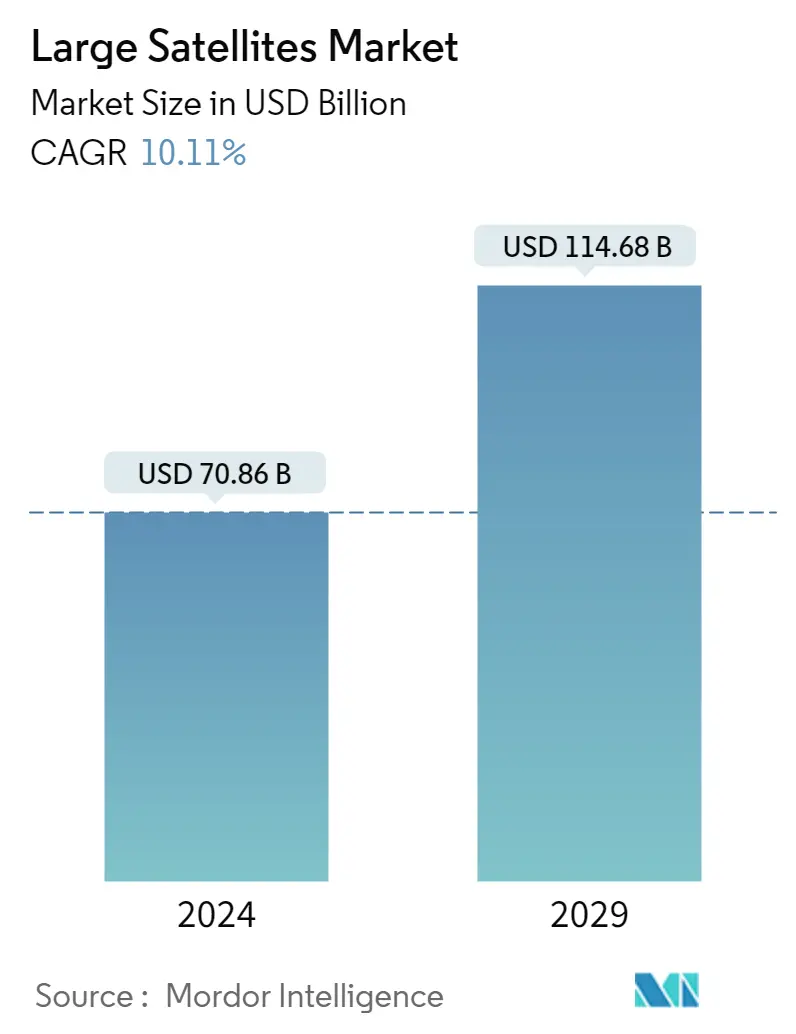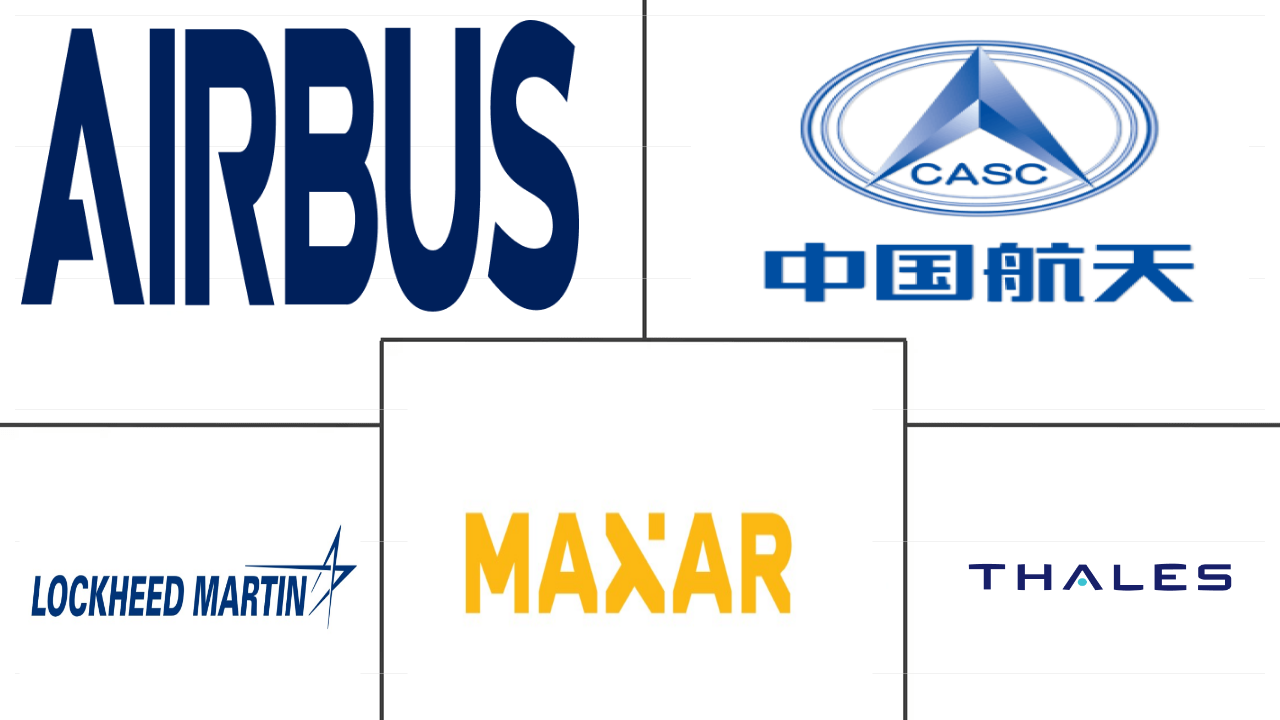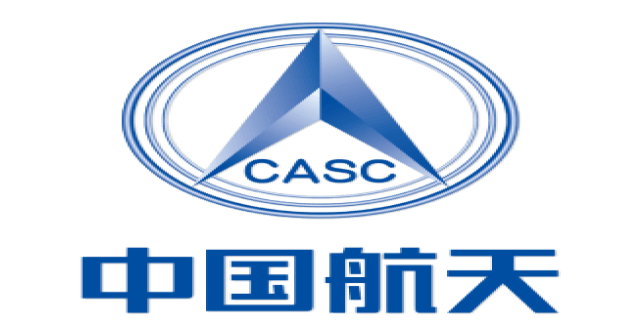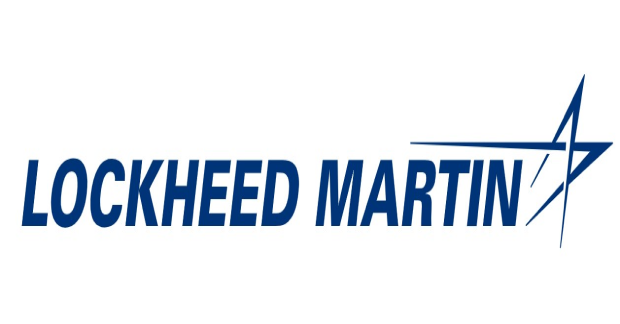Large Satellites Market Size

|
|
Study Period | 2017 - 2029 |
|
|
Market Size (2024) | USD 70.86 Billion |
|
|
Market Size (2029) | USD 114.68 Billion |
|
|
Largest Share by Orbit Class | LEO |
|
|
CAGR (2024 - 2029) | 10.11 % |
|
|
Largest Share by Region | Asia-Pacific |
Major Players |
||

|
||
|
*Disclaimer: Major Players sorted in no particular order |
Large Satellites Market Analysis
The Large Satellites Market size is estimated at USD 70.86 billion in 2024, and is expected to reach USD 114.68 billion by 2029, growing at a CAGR of 10.11% during the forecast period (2024-2029).
70.86 Billion
Market Size in 2024 (USD)
114.68 Billion
Market Size in 2029 (USD)
-1.63 %
CAGR (2017-2023)
10.11 %
CAGR (2024-2029)
Largest Market by Propulsion Tech
73.93 %
value share, Liquid Fuel, 2022
Due to its high efficiency, controllability, reliability, and long lifespan, liquid fuel-based propulsion technology is an ideal choice for space missions. It can be used in various orbit classes for satellites.
Largest Market by Application
49.16 %
value share, Earth Observation, 2022
Earth observation satellites are used for weather forecasting, forestry mapping, and pollution monitoring. The growing adoption of VAS by private companies and organizations is likely to fuel the growth of satellite-based Earth observation.
Largest Market by Satellite Subsystem
25 %
value share, Propulsion Hardware and Propellant, 2022
The demand for these satellite bus & subsystems is driven by the development and launch of mass satellite constellations into space.
Leading Market Player
47.45 %
market share, China Aerospace Science and Technology Corporation (CASC), 2022

China Aerospace Science and Technology Corporation is the largest player in the global large satellites market. CASC offers a diverse range of launch vehicles and adopts a competitive pricing strategy to attract customers across the world.
Second Leading Market Player
19.19 %
market share, Lockheed Martin Corporation, 2022

Lockheed Martin is the second leading player in the global large satellites market. It has a strong product portfolio for military satellites. The company's civil and military customers include USAF, the US Navy, DARPA, NASA, and NOAA.
LEO segment leads the market’s growth with a market share of 57.9% in 2029
- Over the past decade, large satellites have been launched in GEO. GEO occupied a market share of 79.8% in 2017. These satellites cost more, and their life span is on a higher side. Manufacturers spent large amounts of money to launch and deploy these satellites. However, with the advancements in technology, the cost of launching and developing satellites has been reduced over the past 3 to 4 years. Because of this, the viability of manufacturers to launch a large satellite in LEO also increased at a much larger pace.
- Depending on the type of application or mission, a particular satellite or entire satellite constellation is launched in different types of orbit. Different satellites manufactured and launched across all the regions have different applications. For instance, during 2017-2022, out of the 214 large satellites launched, 123, 71, 13, and 7 were placed in GEO, LEO, MEO, and elliptical orbits.
- With respect to the market shares, LEO is expected to lead the segment; it occupies a share of 50.5% in 2023, which is expected to reach 57.1% by 2029. The high market share is because of its proximity and several other advantages triggered by technological developments. GEO has a share of 44.3% in 2023 and is expected to occupy 36.9% in 2029.
- Therefore, the increasing use of satellites in electronic intelligence, Earth science/meteorology, laser imaging, optical imaging, and meteorology departments is expected to drive the demand for the development of satellites during the forecast period.
The increasing number of satellites with long lifespans helps the Asia-Pacific region maintain a substantial market share
- Large satellites are used for a wide range of applications, including communication, navigation, and Earth observation. As the demand for these applications continues to increase, companies are investing in R&D to develop large satellites to meet these needs.
- Large satellites are designed primarily for operational purposes with a long lifespan (between five and 10 years). These satellites are mainly used to carry larger remote sensing payloads or larger numbers of transponders and larger antennas for communication purposes. These operational satellites have redundancy for all major subsystems to support accidental failures in subsystems and extend lifespan. Larger satellites are typically built with radiation-hardened space-grade electronics. They generate more power with larger deployable solar panels to support all subsystems and larger loads. Since large satellites have large solar panels and bodies, they face greater atmospheric drag, generating the need for high-powered propulsion systems. Large satellites generally carry a chemical propulsion system for orbital elevation and attitude correction.
- During 2017-2022, around 200+ large satellites launched were owned by North American organizations and had applications such as electronic intelligence, Earth science/meteorology, laser imaging, electronic intelligence, optical imaging, and meteorology. Asia-Pacific is expected to dominate the market during the forecast period, with a share of more than 60%.
Global Large Satellites Market Trends
Trend for better fuel and operational efficiency has been witnessed
- The mass of a satellite has a significant impact on the launch of the satellite. This is because the heavier the satellite, the more fuel and energy are required to launch it into space. The launch of a satellite involves accelerating it to a very high speed, typically around 28,000 kilometers per hour, in order to place it in orbit around the Earth. The amount of energy required to achieve this speed is proportional to the mass of the satellite.
- Galaxy 33 and Galaxy 34, local communications satellites developed by Intelsat, were launched in October 2022 in the United States. These were among the world's most notable development and launches of satellites. Similarly, in March 2022, a Geostationary Active Environmental Satellite was launched by Lockheed Martin, which is an advanced weather satellite. In Europe, satellite I-6 F2 is planned to be launched in 2023.
- As a result, a heavier satellite requires a larger rocket and more fuel to launch it into space. This, in turn, increases the cost of the launch and can also limit the types of launch vehicles that can be used. The major classification types according to mass are large satellites that are more than 1,000 kg. These large satellites are majorly designed for operational purposes with a long lifespan. These satellites are being adopted by various countries to carry larger remote sensing payloads, larger numbers of transponders, and larger antennas for communication purposes. These operational satellites have redundancy for all major subsystems to support accidental failures in subsystems. Larger satellites are typically built with radiation-hardened space-grade electronics. During the period 2017-2022, around 200+ large satellites were manufactured and launched globally.
Increasing space expenditures of different space agencies globally is expected to positively impact the large satellites category
- R&D expenditure on large satellites is an important factor in driving innovation and technology development in the satellite industry. In recent years, the global trend in R&D expenditure on large satellites continues to rise, owing to several factors, including rapid advancements in satellite technology, new materials, propulsion systems, and electronics, which are driving the need for R&D investment to design and develop large satellites that can take advantage of these innovations.
- Large satellites are used for a wide range of applications, including communication, navigation, and Earth observation. As the demand for these applications continues to grow, companies are investing in R&D to develop large satellites that can meet these needs. Currently, in the Asia-Pacific region, China, India, and Japan possess a complete end-to-end space capacity and space infrastructure, space technology (communication, Earth observation (EO), and navigation satellites), satellite manufacturing, rockets, and spaceports. Other countries in the region are required to rely on international cooperation to carry out their respective space programs. In June 2022, the Nuri rocket was launched by South Korea, putting six satellites into orbit, making it the seventh country in the world to successfully launch a payload weighing more than one ton onto an air launch vehicle.
- The South Korean government, in its 2022 budget, announced an investment of USD 619 million in the space segment, which includes the development of a spaceport, the construction of a satellite navigation system, and a 6G communications network. The spending on space and research grants is expected to surge in the region, thereby increasing the sector's importance in every domain of the global economy..
Large Satellites Industry Overview
The Large Satellites Market is fairly consolidated, with the top five companies occupying 82.66%. The major players in this market are Airbus SE, China Aerospace Science and Technology Corporation (CASC), Lockheed Martin Corporation, Maxar Technologies Inc. and Thales (sorted alphabetically).
Large Satellites Market Leaders
Airbus SE
China Aerospace Science and Technology Corporation (CASC)
Lockheed Martin Corporation
Maxar Technologies Inc.
Thales
Other important companies include Indian Space Research Organisation (ISRO), Information Satellite Systems Reshetnev, Mitsubishi Heavy Industries, The Boeing Company.
*Disclaimer: Major Players sorted in alphabetical order.
Large Satellites Market News
- January 2023: The UK government announced its plans to harness the space defense capabilities of Airbus Defense and Space under a new major partnership agreement. The company, one of UK's leading space companies, has become a partner of the UK Department of Defense Missile Defense Center (MDC), the country's center of excellence for missile defense.
- January 2023: Airbus signed a contract with the Belgian Ministry of Defense to provide tactical satellite communications services to the armed forces for a period of 15 years. Airbus plans to launch a new ultra-high frequency (UHF) communications service by 2024 for the armed forces of other European nations and NATO allies.
- September 2022: China successfully sent two BeiDou satellites into space from the Xichang Satellite Launch Center. The new satellites and boosters were developed by the China Academy of Space Technology (CAST) and the China Academy of Launch Vehicle Technology, under the China Aerospace Science and Technology Corporation.
Free with this Report
We offer a comprehensive set of global and local metrics that illustrate the fundamentals of the satellites industry. Clients can access in-depth market analysis of various satellites and launch vehicles through granular level segmental information supported by a repository of market data, trends, and expert analysis. Data and analysis on satellite launches, satellite mass, application of satellites, spending on space programs, propulsion systems, end users, etc., are available in the form of comprehensive reports as well as excel based data worksheets.
Large Satellites Market Report - Table of Contents
1. EXECUTIVE SUMMARY & KEY FINDINGS
2. REPORT OFFERS
3. INTRODUCTION
- 3.1 Study Assumptions & Market Definition
- 3.2 Scope of the Study
- 3.3 Research Methodology
4. KEY INDUSTRY TRENDS
- 4.1 Satellite Mass
- 4.2 Spending On Space Programs
-
4.3 Regulatory Framework
- 4.3.1 Global
- 4.3.2 Australia
- 4.3.3 Brazil
- 4.3.4 Canada
- 4.3.5 China
- 4.3.6 France
- 4.3.7 Germany
- 4.3.8 India
- 4.3.9 Iran
- 4.3.10 Japan
- 4.3.11 New Zealand
- 4.3.12 Russia
- 4.3.13 Singapore
- 4.3.14 South Korea
- 4.3.15 United Arab Emirates
- 4.3.16 United Kingdom
- 4.3.17 United States
- 4.4 Value Chain & Distribution Channel Analysis
5. MARKET SEGMENTATION (includes market size in Value in USD, Forecasts up to 2029 and analysis of growth prospects)
-
5.1 Application
- 5.1.1 Communication
- 5.1.2 Earth Observation
- 5.1.3 Navigation
- 5.1.4 Space Observation
- 5.1.5 Others
-
5.2 Orbit Class
- 5.2.1 GEO
- 5.2.2 LEO
- 5.2.3 MEO
-
5.3 End User
- 5.3.1 Commercial
- 5.3.2 Military & Government
- 5.3.3 Other
-
5.4 Propulsion Tech
- 5.4.1 Electric
- 5.4.2 Gas based
- 5.4.3 Liquid Fuel
-
5.5 Region
- 5.5.1 Asia-Pacific
- 5.5.2 Europe
- 5.5.3 North America
- 5.5.4 Rest of World
6. COMPETITIVE LANDSCAPE
- 6.1 Key Strategic Moves
- 6.2 Market Share Analysis
- 6.3 Company Landscape
-
6.4 Company Profiles (includes Global Level Overview, Market Level Overview, Core Business Segments, Financials, Headcount, Key Information, Market Rank, Market Share, Products and Services, and Analysis of Recent Developments).
- 6.4.1 Airbus SE
- 6.4.2 China Aerospace Science and Technology Corporation (CASC)
- 6.4.3 Indian Space Research Organisation (ISRO)
- 6.4.4 Information Satellite Systems Reshetnev
- 6.4.5 Lockheed Martin Corporation
- 6.4.6 Maxar Technologies Inc.
- 6.4.7 Mitsubishi Heavy Industries
- 6.4.8 Thales
- 6.4.9 The Boeing Company
7. KEY STRATEGIC QUESTIONS FOR SATELLITE CEOS
8. APPENDIX
-
8.1 Global Overview
- 8.1.1 Overview
- 8.1.2 Porter's Five Forces Framework
- 8.1.3 Global Value Chain Analysis
- 8.1.4 Market Dynamics (DROs)
- 8.2 Sources & References
- 8.3 List of Tables & Figures
- 8.4 Primary Insights
- 8.5 Data Pack
- 8.6 Glossary of Terms
List of Tables & Figures
- Figure 1:
- SATELLITE MASS (ABOVE 10KG) GLOBALLY, NUMBER OF SATELLITES LAUNCHED, GLOBAL, 2017 - 2022
- Figure 2:
- SPENDING ON SPACE PROGRAMS GLOBALLY, USD, GLOBAL, 2017 - 2022
- Figure 3:
- GLOBAL LARGE SATELLITES MARKET, VALUE, USD, 2017 - 2029
- Figure 4:
- VALUE OF LARGE SATELLITES MARKET BY APPLICATION, USD, GLOBAL, 2017 - 2029
- Figure 5:
- VALUE SHARE OF LARGE SATELLITES MARKET BY APPLICATION, %, GLOBAL, 2017 VS 2023 VS 2029
- Figure 6:
- VALUE OF COMMUNICATION MARKET, USD, GLOBAL, 2017 - 2029
- Figure 7:
- VALUE OF EARTH OBSERVATION MARKET, USD, GLOBAL, 2017 - 2029
- Figure 8:
- VALUE OF NAVIGATION MARKET, USD, GLOBAL, 2017 - 2029
- Figure 9:
- VALUE OF SPACE OBSERVATION MARKET, USD, GLOBAL, 2017 - 2029
- Figure 10:
- VALUE OF OTHERS MARKET, USD, GLOBAL, 2017 - 2029
- Figure 11:
- VALUE OF LARGE SATELLITES MARKET BY ORBIT CLASS, USD, GLOBAL, 2017 - 2029
- Figure 12:
- VALUE SHARE OF LARGE SATELLITES MARKET BY ORBIT CLASS, %, GLOBAL, 2017 VS 2023 VS 2029
- Figure 13:
- VALUE OF GEO MARKET, USD, GLOBAL, 2017 - 2029
- Figure 14:
- VALUE OF LEO MARKET, USD, GLOBAL, 2017 - 2029
- Figure 15:
- VALUE OF MEO MARKET, USD, GLOBAL, 2017 - 2029
- Figure 16:
- VALUE OF LARGE SATELLITES MARKET BY END USER, USD, GLOBAL, 2017 - 2029
- Figure 17:
- VALUE SHARE OF LARGE SATELLITES MARKET BY END USER, %, GLOBAL, 2017 VS 2023 VS 2029
- Figure 18:
- VALUE OF COMMERCIAL MARKET, USD, GLOBAL, 2017 - 2029
- Figure 19:
- VALUE OF MILITARY & GOVERNMENT MARKET, USD, GLOBAL, 2017 - 2029
- Figure 20:
- VALUE OF OTHER MARKET, USD, GLOBAL, 2017 - 2029
- Figure 21:
- VALUE OF LARGE SATELLITES MARKET BY PROPULSION TECH, USD, GLOBAL, 2017 - 2029
- Figure 22:
- VALUE SHARE OF LARGE SATELLITES MARKET BY PROPULSION TECH, %, GLOBAL, 2017 VS 2023 VS 2029
- Figure 23:
- VALUE OF ELECTRIC MARKET, USD, GLOBAL, 2017 - 2029
- Figure 24:
- VALUE OF GAS BASED MARKET, USD, GLOBAL, 2017 - 2029
- Figure 25:
- VALUE OF LIQUID FUEL MARKET, USD, GLOBAL, 2017 - 2029
- Figure 26:
- VALUE OF LARGE SATELLITES MARKET BY REGION, USD, GLOBAL, 2017 - 2029
- Figure 27:
- VALUE SHARE OF LARGE SATELLITES MARKET BY REGION, %, GLOBAL, 2017 VS 2023 VS 2029
- Figure 28:
- VALUE OF LARGE SATELLITES MARKET, USD, ASIA-PACIFIC, 2017 - 2029
- Figure 29:
- VALUE SHARE OF LARGE SATELLITES MARKET BY APPLICATION, %, ASIA-PACIFIC, 2017 - 2029
- Figure 30:
- VALUE OF LARGE SATELLITES MARKET, USD, EUROPE, 2017 - 2029
- Figure 31:
- VALUE SHARE OF LARGE SATELLITES MARKET BY APPLICATION, %, EUROPE, 2017 - 2029
- Figure 32:
- VALUE OF LARGE SATELLITES MARKET, USD, NORTH AMERICA, 2017 - 2029
- Figure 33:
- VALUE SHARE OF LARGE SATELLITES MARKET BY APPLICATION, %, NORTH AMERICA, 2017 - 2029
- Figure 34:
- VALUE OF LARGE SATELLITES MARKET, USD, REST OF WORLD, 2017 - 2029
- Figure 35:
- VALUE SHARE OF LARGE SATELLITES MARKET BY APPLICATION, %, REST OF WORLD, 2017 - 2029
- Figure 36:
- NUMBER OF STRATEGIC MOVES OF MOST ACTIVE COMPANIES, GLOBAL LARGE SATELLITES MARKET, ALL, 2017 - 2029
- Figure 37:
- TOTAL NUMBER OF STRATEGIC MOVES OF COMPANIES, GLOBAL LARGE SATELLITES MARKET, ALL, 2017 - 2029
- Figure 38:
- MARKET SHARE OF GLOBAL LARGE SATELLITES MARKET, %, ALL, 2022
Large Satellites Industry Segmentation
Communication, Earth Observation, Navigation, Space Observation, Others are covered as segments by Application. GEO, LEO, MEO are covered as segments by Orbit Class. Commercial, Military & Government are covered as segments by End User. Electric, Gas based, Liquid Fuel are covered as segments by Propulsion Tech. Asia-Pacific, Europe, North America are covered as segments by Region.
- Over the past decade, large satellites have been launched in GEO. GEO occupied a market share of 79.8% in 2017. These satellites cost more, and their life span is on a higher side. Manufacturers spent large amounts of money to launch and deploy these satellites. However, with the advancements in technology, the cost of launching and developing satellites has been reduced over the past 3 to 4 years. Because of this, the viability of manufacturers to launch a large satellite in LEO also increased at a much larger pace.
- Depending on the type of application or mission, a particular satellite or entire satellite constellation is launched in different types of orbit. Different satellites manufactured and launched across all the regions have different applications. For instance, during 2017-2022, out of the 214 large satellites launched, 123, 71, 13, and 7 were placed in GEO, LEO, MEO, and elliptical orbits.
- With respect to the market shares, LEO is expected to lead the segment; it occupies a share of 50.5% in 2023, which is expected to reach 57.1% by 2029. The high market share is because of its proximity and several other advantages triggered by technological developments. GEO has a share of 44.3% in 2023 and is expected to occupy 36.9% in 2029.
- Therefore, the increasing use of satellites in electronic intelligence, Earth science/meteorology, laser imaging, optical imaging, and meteorology departments is expected to drive the demand for the development of satellites during the forecast period.
| Application | Communication |
| Earth Observation | |
| Navigation | |
| Space Observation | |
| Others | |
| Orbit Class | GEO |
| LEO | |
| MEO | |
| End User | Commercial |
| Military & Government | |
| Other | |
| Propulsion Tech | Electric |
| Gas based | |
| Liquid Fuel | |
| Region | Asia-Pacific |
| Europe | |
| North America | |
| Rest of World |
Market Definition
- Application - Various applications or purposes of the satellites are classified into communication, earth observation, space observation, navigation, and others. The purposes listed are those self-reported by the satellite’s operator.
- End User - The primary users or end users of the satellite is described as civil (academic, amateur), commercial, government (meteorological, scientific, etc.), military. Satellites can be multi-use, for both commercial and military applications.
- Launch Vehicle MTOW - The launch vehicle MTOW (maximum take-off weight) means the maximum weight of the launch vehicle during take-off, including the weight of payload, equipment and fuel.
- Orbit Class - The satellite orbits are divided into three broad classes namely GEO, LEO, and MEO. Satellites in elliptical orbits have apogees and perigees that differ significantly from each other and categorized satellite orbits with eccentricity 0.14 and higher as elliptical.
- Propulsion tech - Under this segment, different types of satellite propulsion systems have been classified as electric, liquid-fuel and gas-based propulsion systems.
- Satellite Mass - Under this segment, different types of satellite propulsion systems have been classified as electric, liquid-fuel and gas-based propulsion systems.
- Satellite Subsystem - All the components and subsystems which includes propellants, buses, solar panels, other hardware of satellites are included under this segment.
| Keyword | Definition |
|---|---|
| Attitude Control | The orientation of the satellite relative to the Earth and the sun. |
| INTELSAT | The International Telecommunications Satellite Organization operates a network of satellites for international transmission. |
| Geostationary Earth Orbit (GEO) | Geostationary satellites in Earth orbit 35,786 km (22,282 mi) above the equator in the same direction and at the same speed as the earth rotates on its axis, making them appear fixed in the sky. |
| Low Earth Orbit (LEO) | Low Earth Orbit satellites orbit from 160-2000km above the earth, take approximately 1.5 hours for a full orbit and only cover a portion of the earth’s surface. |
| Medium Earth Orbit (MEO) | MEO satellites are located above LEO and below GEO satellites and typically travel in an elliptical orbit over the North and South Pole or in an equatorial orbit. |
| Very Small Aperture Terminal (VSAT) | Very Small Aperture Terminal is an antenna that is typically less than 3 meters in diameter |
| CubeSat | CubeSat is a class of miniature satellites based on a form factor consisting of 10 cm cubes. CubeSats weigh no more than 2 kg per unit and typically use commercially available components for their construction and electronics. |
| Small Satellite Launch Vehicles (SSLVs) | Small Satellite Launch Vehicle (SSLV) is a three-stage Launch Vehicle configured with three Solid Propulsion Stages and a liquid propulsion-based Velocity Trimming Module (VTM) as a terminal stage |
| Space Mining | Asteroid mining is the hypothesis of extracting material from asteroids and other asteroids, including near-Earth objects. |
| Nano Satellites | Nanosatellites are loosely defined as any satellite weighing less than 10 kilograms. |
| Automatic Identification System (AIS) | Automatic identification system (AIS) is an automatic tracking system used to identify and locate ships by exchanging electronic data with other nearby ships, AIS base stations, and satellites. Satellite AIS (S-AIS) is the term used to describe when a satellite is used to detect AIS signatures. |
| Reusable launch vehicles (RLVs) | Reusable launch vehicle (RLV) means a launch vehicle that is designed to return to Earth substantially intact and therefore may be launched more than one time or that contains vehicle stages that may be recovered by a launch operator for future use in the operation of a substantially similar launch vehicle. |
| Apogee | The point in an elliptical satellite orbit which is farthest from the surface of the earth. Geosynchronous satellites which maintain circular orbits around the earth are first launched into highly elliptical orbits with apogees of 22,237 miles. |
Research Methodology
Mordor Intelligence follows a four-step methodology in all our reports.
- Step-1: Identify Key Variables: In order to build a robust forecasting methodology, the variables and factors identified in Step-1 are tested against available historical market numbers. Through an iterative process, the variables required for market forecast are set and the model is built on the basis of these variables.
- Step-2: Build a Market Model: Market-size estimations for the historical and forecast years have been provided in revenue and volume terms. For sales conversion to volume, the average selling price (ASP) is kept constant throughout the forecast period for each country, and inflation is not a part of the pricing.
- Step-3: Validate and Finalize: In this important step, all market numbers, variables and analyst calls are validated through an extensive network of primary research experts from the market studied. The respondents are selected across levels and functions to generate a holistic picture of the market studied.
- Step-4: Research Outputs: Syndicated Reports, Custom Consulting Assignments, Databases & Subscription Platforms.








